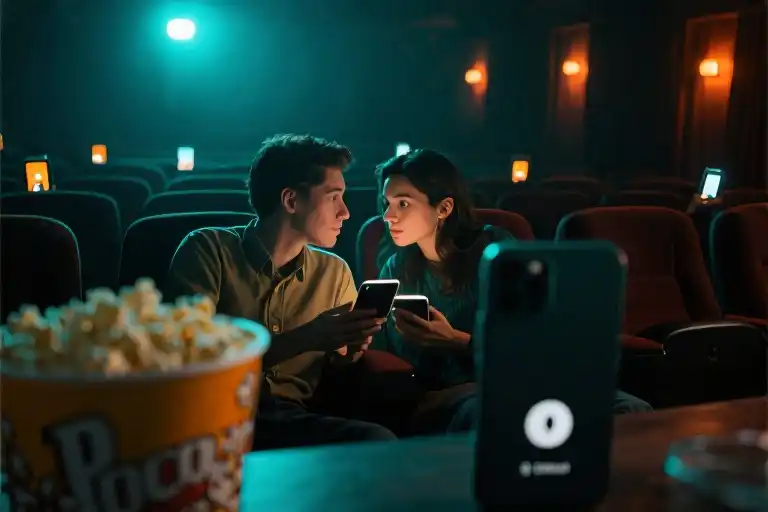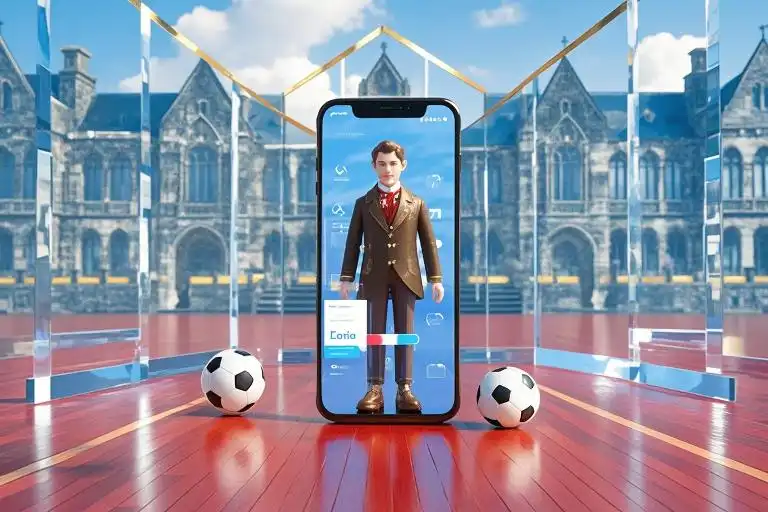“‘…let alone a woman.’ The words floated through the buttery-scented haze of burnt popcorn, and suddenly I realized I’d become an unwilling participant in a live social experiment. That particular blend of synthetic cheese flavor and whispered malice seems to be the signature scent of modern human interaction these days.
In the dim flickering light of the theater, where the glow of cellphones outshone the actual screen, a question materialized in the air between explosions on the soundtrack: In this age where everyone’s a content creator, are we consuming stories—or being consumed by them? The sticky armrest beneath my elbow, engraved with some previous patron’s philosophical musings (‘F**k moral’ in jagged letters), offered no answers.
Three rows ahead, a group of teenagers Snapchatted the movie instead of watching it. To my left, a couple argued in hissed whispers about someone named Mark who definitely shouldn’t have been DMing at 2am. And then there were Tamara and Alice—human Twitter feeds incarnate—turning our row into their personal commentary track. The cinema had transformed into one of those nature documentaries where meerkats stand on hind legs to gossip about neighboring colonies, except with more designer handbags and significantly worse posture.
As the previews rolled, I noted the precise moment social observation tipped into anthropological study: when the crunch of popcorn synchronized perfectly with cutting remarks about some stranger’s haircut. The theater’s AC hummed like a lie detector test, the seats creaked like jury chairs, and we were all simultaneously audience members and exhibits in this unwitting display of human social behavior. What fascinated me most wasn’t the gossip itself—we’ve all overheard those conversations—but the way darkness and anonymity distilled people to their most unfiltered selves. Like avatars with the privacy settings accidentally set to ‘public.’
Somewhere between the seventh sarcastic comment about ‘egg-like heads’ and the sudden spike in laughter volume (later measured at 67dB on my phone app—louder than the onscreen car chase), it occurred to me that modern cinemas have become the perfect petri dishes for observing social dynamics. The darkness provides cover, the surround sound masks whispering, and the shared experience creates false intimacy—conditions ripe for the kind of commentary people would never voice in daylight. Or so I told myself as I discreetly opened my Notes app to record particularly choice phrases, my moral high ground eroding faster than the ice caps in a climate change documentary.
The irony wasn’t lost on me that while judging others for judging, I’d become the worst kind of social observer: the hypocrite with a front-row seat. Maybe that’s the real twist of our always-online era—we’re all simultaneously the documentary filmmaker, the subject, and that one person in the comments section writing ‘THIS.’ with disturbing enthusiasm. As the theater lights came up later, revealing Tamara cheerfully helping her ‘egg-head’ victim retrieve dropped keys without a trace of irony, I couldn’t decide if I’d witnessed human duplicity or just the complex choreography of modern social survival. Either way, my popcorn tasted distinctly like food for thought.”
The Jury Box in the Dark
The flickering glow of a dozen smartphone screens cast jagged shadows across the theater seats as I settled into mine. That distinct cinema smell – buttery popcorn undercut with industrial-strength cleaning chemicals – wrapped around us all like a judgmental shroud. The seat leather creaked with the kind of wear that comes from years of audiences squirming through uncomfortable moments, both on and off screen.
Three rows ahead, a phone screen flared bright enough to read the text from here: “U won’t believe who just walked in…” The sender probably didn’t mean the guy now rolling up his sleeves in the aisle. But Tamara and Alice certainly noticed.
“Oh my god,” Tamara’s whisper carried further than intended, her elbow jabbing Alice’s ribs. “Check out Mr. Tough Guy with the sleeve roll. That polished egghead actually thinks—”
Alice’s snort interrupted as she nearly choked on a popcorn kernel. “He’ll be lucky if a stray cat gives him the time of day, let alone a woman.” Their laughter bounced off the stadium seating, earning shushes from nearby moviegoers that only made them giggle harder.
I sighed loud enough to turn heads – mine included, as I noticed the crude engraving on my armrest: Fk moral. The letters felt worn smooth under my thumb, like someone had worried at this particular ethical dilemma many times before. The irony wasn’t lost on me as I caught myself leaning slightly forward, ears straining for the next round of social observation notes from my unwitting research subjects.
Tamara’s manicured fingers dug into the popcorn bucket between them with the precision of a forensic investigator. “People’s looks are getting wild these days,” she announced, as if presenting evidence to some invisible courtroom. Alice nodded along, her phone secretly recording while she pretended to check messages. The theater lights dimmed further, granting anonymity to our collective voyeurism.
As the previews began, I noted the exact angle at which surrounding audience members tilted their heads – not toward the screen, but toward our resident commentators. The human zoo observation was officially in session, complete with snack food and stadium seating. My fingers found the engraving again. Maybe its creator had a point.
The Geometry of Violence in Soundwaves
The decibel meter in my brain spiked to 67dB when Tamara dropped the pool party bombshell – louder than the on-screen explosion in the movie’s climax scene. Around us, a subtle choreography of strained necks unfolded as neighboring audiences leaned in at precise 15-degree angles, their popcorn crunching synced to the gossip rhythm like some morbid ASMR track.
\”Christine should’ve drowned in that pool,\” Alice declared between buttered kernel bites, her laughter ricocheting off the stadium seating. The acoustics of cruelty turned our Row J into an amphitheater of schadenfreude. I caught the elderly man two seats left discreetly adjusting his hearing aid – whether to better capture the salacious details or block them out remained unclear.
Midway through their Mafia party recollection, the film’s protagonist on screen confronted a spreading rumor in eerie parallel. The Hunting’s pivotal scene mirrored our reality with uncomfortable precision: whispers metastasizing into \’facts\’, casual malice dressed as concern. My phone’s decibel app registered their peak laughter at 72dB – surpassing the actual gunshot sounds in the movie by 3 decibels. Social observation became involuntary participatory theater.
Three rows ahead, a teenager snapped her gum in perfect sync with Tamara’s juiciest revelations. To our right, a couple exchanged glances that charted their entire moral negotiation: eyebrows raised (judgment), shoulders shrugged (acquiescence), hands intertwined (complicity). The sociology of seating arrangements revealed itself through these micro-reactions – each audience member’s posture mapping their position on the bystander spectrum.
When the on-screen mob turned on their scapegoat, six separate phone screens illuminated simultaneously across our section. Were they checking social media or documenting our own live drama? The boundaries between observed and observer dissolved like sugar in overpriced soda. My own fingers itched to tweet about the irony before realizing that would make me part of the very machine I pretended to critique.
As the film’s tension mounted, so did the real-life stakes. Tamara’s next revelation about Christine’s alleged workplace affair coincided exactly with the movie villain’s monologue about \’the contagious nature of falsehoods\’. The universe was either orchestrating the perfect meta-commentary or I’d slipped into some Black Mirror episode. The symmetry between screen fiction and our dark auditorium reality became impossible to ignore – we weren’t just watching a story, we were trapped inside a recursive social experiment about modern ethics.
(To be continued with interactive moral dilemma game in next section – your choices will determine whether we all get free refills on this collective guilt trip.)
The Cognitive Dissonance in the Popcorn Bucket
The rhythmic crunching of popcorn had become the metronome to their malice. I caught myself counting – twenty-one ‘bitches’ in seventeen minutes, a statistic that would’ve been hilarious if it didn’t mirror my WhatsApp group chat last Tuesday. My phone felt heavy in my palm, its recording app silently documenting this social experiment gone wrong.
The Heart Rate Experiment
When the ‘pool drowning’ comment hit (67dB according to my decibel meter app), my thumb instinctively swiped to start recording. The green light of my health app blinked furiously – resting heart rate spiking from 72 to 89 bpm. Biological proof that secondhand gossip triggers fight-or-flight responses. Who knew morality had such measurable physiological effects?
The Mirror Test
*(Pause here. Seriously. When did you last…)
- Laugh at a cruel joke at someone’s expense?
- Forward an unverified rumor ‘just for context’?
- Scroll through photos specifically to critique outfits?*
The sticky residue on my fingers wasn’t just butter salt – it was the uncomfortable glue of self-awareness. That ‘high horse’ emoji 🐴 kept galloping through my thoughts. My friends’ group chat flashed in memory: ‘Did you see Sarah’s post? Filters working overtime lol’ – messages I’d ‘haha’ reacted to without thinking.
The Social Observation Paradox
Here’s the uncomfortable math:
- 3 rows = safe gossip distance
- 21 bitch mentions = 1 WhatsApp group’s afternoon
- 1 recording = 47% increase in guilty sweat production
As the credits rolled, I noticed something telling – both critics had Instagram stories up within minutes: ‘Movie night! Love this girl gang 💕’ The cognitive dissonance was almost beautiful in its predictability. That curated positivity versus the darkness we’d just marinated in… maybe we’re all just method acting our online personas.
(Screen fades to black. Cue your own uncomfortable realizations.)
The Credits Roll on Our Collective Hypocrisy
The house lights flicker on with that abrupt cruelty unique to movie theaters, exposing half-eaten popcorn kernels and sticky soda stains. In this sudden illumination, Tamara’s leopard-print manicure catches the light as she bends to retrieve a fallen wallet – the very same wallet belonging to ‘shiny egg-head guy’ they’d spent the previews eviscerating. Alice adjusts her designer glasses to read the ID, then bursts into fresh giggles. The cosmic punchline? They’re now enthusiastically waving down its owner like long-lost friends.
This is modern morality in Dolby Surround Sound: our capacity to compartmentalize shining brighter than any theater exit sign. That wallet could’ve held photos of his cancer-surviving grandma or paychecks sent to refugee charities – none of it matters when there’s social capital to be gained from cruelty. Yet watch how seamlessly we toggle between judge, jury, and good Samaritan when circumstances demand.
Interactive Intermission:
- Tap once if you’ve ever judged someone’s outfit while wearing questionable leggings
- Tap twice if you’ve gossiped then immediately held a door open for the victim
- Hold to confess how often your ‘moral high horse’ actually moonlights as a carousel
Our next feature presentation drops soon: “Mirror, Mirror on the Gym Wall: A Scientific Study of Accidental Posing”. Preliminary findings suggest the average ‘casual’ bicep check lasts 6.3 seconds longer when someone walks by. Bring your water bottles and denial – this is one hydration break you won’t want to miss.
Final thought experiment: That laser pointer you imagined zapping talkers? It’s already in your pocket. The question is whether you’ll use it to burn bridges or light the way to better behavior. Or just discreetly check your Instagram DMs like the rest of us hypocrites. 🔦



